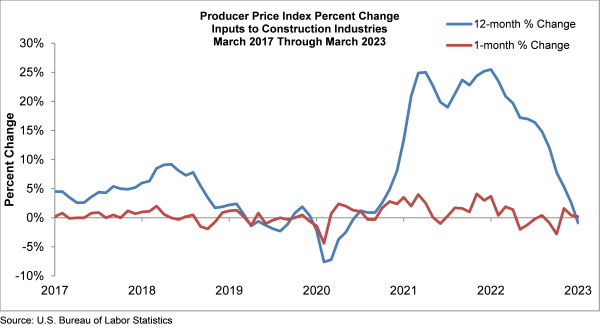Construction input prices increased 0.2% in March, according to an Associated Builders and Contractors analysis of U.S. Bureau of Labor Statistics Producer Price Index data released today. Nonresidential construction input prices rose 0.4% for the month.
Overall construction input prices are 0.9% lower than in March 2022, while nonresidential construction input prices have fallen 0.6% over the past year. Construction input prices are now up 39.0% since February 2020, the month before the COVID-19 pandemic began.
“Construction input costs are down on a year-over-year basis for the first time since August 2020,” said ABC Chief Economist Anirban Basu. “The good news is that the latest PPI data, which show broad-based declines in both goods and services prices, suggest that the expected 25 basis point interest rate hike at the Federal Reserve’s May meeting will be the last of the cycle.
“The bad news is that this data indicates greatly diminished pricing power among wholesalers and others,” said Basu. “While some will cheer the notion that rate increases are set to end soon, the Federal Reserve may want to maintain higher interest rates for longer to ensure that inflation has been suppressed. This, along with other signs of slowing economic activity, suggests that the possibility of recession remains elevated, though the economic outlook is increasingly uncertain.”


Related Stories
Hotel Facilities | Sep 6, 2017
Marriott has the largest construction pipeline of any franchise company in the U.S.
Marriott has the most rooms currently under construction with 482 Projects/67,434 Rooms.
Market Data | Sep 5, 2017
Nonresidential construction declines again, public and private sector down in July
Weakness in spending was widespread.
Market Data | Aug 29, 2017
Hidden opportunities emerge from construction industry challenges
JLL’s latest construction report shows stability ahead with tech and innovation leading the way.
Market Data | Aug 28, 2017
U.S. hotel construction pipeline is up 7% year-over-year
For the economy, the rate of growth may be low but it’s running on all cylinders.
Market Data | Aug 23, 2017
Architecture Billings Index growth moderates
“The July figures show the continuation of healthy trends in the construction sector of our economy,” said AIA Chief Economist, Kermit Baker.
Architects | Aug 21, 2017
AIA: Architectural salaries exceed gains in the broader economy
AIA’s latest compensation report finds average compensation for staff positions up 2.8% from early 2015.
Market Data | Aug 20, 2017
Some suburban office markets are holding their own against corporate exodus to cities
An analysis of mortgage-backed loans suggests that demand remains relatively steady.
Market Data | Aug 17, 2017
Marcum Commercial Construction Index reports second quarter spending increase in commercial and office construction
Spending in all 12 of the remaining nonresidential construction subsectors retreated on both an annualized and monthly basis.
Industry Research | Aug 11, 2017
NCARB releases latest data on architectural education, licensure, and diversity
On average, becoming an architect takes 12.5 years—from the time a student enrolls in school to the moment they receive a license.
Market Data | Aug 4, 2017
U.S. grand total construction starts growth projection revised slightly downward
ConstructConnect’s quarterly report shows courthouses and sports stadiums to end 2017 with a flourish.
















